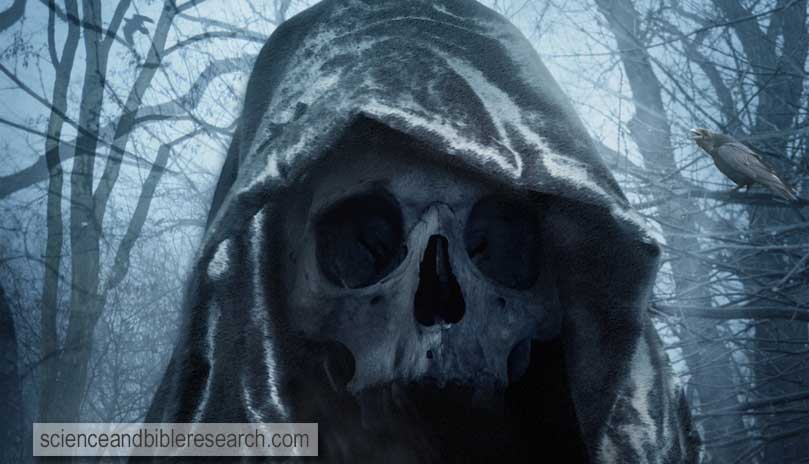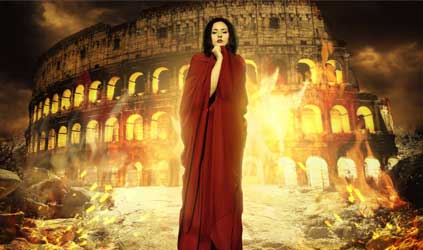September 1, 2018
Steve Sabz

The angel of death, demon of darkness (Photo by cranach2)
1. Introduction
Are we the last, or terminal generation that will see Christ coming down to earth in heavenly power and glory? As we shall see, this often repeated claim of the Futurist did not originate with modern doomsday-rapture theorists. In fact, many generations of believers within the last two thousand years incorrectly presumed that the world was heading toward certain destruction, and believed Bible prophecy was being fulfilled before their eyes. However, if we investigate the ancient past, we will see that it was much worse in the 3rd century AD when a world-wide persecution of Christians, apostasy and church division, and a devastating plague all occurred simultaneously between the years 250 and 260 AD.
We shall begin our historical narrative with Thascius Caecilius Cyprianus (200-258), or simply, Cyprian, a highly revered bishop in the North African city of Carthage from the year 248 up until his martyrdom ten years later. Before his conversion and baptism circa 246, he practiced law in the same city. Some of the older bishops were against electing a young, new convert like Cyprian to church office according to the apostle Paul's admonition in 1 Timothy 3:6. His almost instantaneous elevation from lawyer to bishop was largely "by the voice of the people,"1 who were at least partly influenced by Cyprian's extravagant generosity to the poor.
Cyprian presided over a flourishing church in Carthage prior to the brutal reigns of Roman emperors Decius (249-251) and Valerian (253-260). Emperor Decius ordered the first ever, empire-wide persecution of Christians. As a result, Cyprian fled to an undisclosed location outside the city, but was able to keep in touch with his congregation through a series of letters.2 His counterpart in the city of Alexandria, Origen (185-254), was martyred. Valerian upheld Decius' decree during his tenure as emperor, during which time Cyprian suffered martyrdom.
It was during this time period that the church fractured for reasons which will be elaborated in the following pages. In the midst of the tribulation-then-division of the church, in addition to a severe plague, Cyprian's end-of-the-world eschatological views emerged.
An analysis of Cyprian's eschatology during three prophetic-like events poses a challenge for believers today: forming one's end-of-the-world expectations around church persecution, division, and plague, or relying on Scripture first and foremost to dictate one's eschatological outlook.
2. Apocalyptic Triad
Three major events which helped form Cyprian's eschatology were the large-scale persecutions administered by Roman emperors Decius and Valerian, the division of the church, and a contemporaneous plague. This section will discuss each of the aforementioned events using primary and secondary source documents, as well as other supporting literature.
Persecution
The empire-wide persecution instituted by Roman emperor Decius (249-251), and afterward renewed by his successor emperor Valerian (253-260), present a unique window into the life of the church. Prior to this time period, hostilities toward Christians were geographically localized and did not affect all believers throughout the empire. For example, the first persecution of Christians by the Roman government began at the behest of emperor Nero (54-68) in 64 AD. His sadistic treatment of the saints, for which he gleefully attached to himself the appellation, "first among God's chief enemies,"3 was confined to the city of Rome. Christians alive during Nero's localized reign of terror were afforded the opportunity to escape to other regions of the empire for safety, thus, heeding the Lord's command (Matthew 10:23, Acts 8:1).
Conversely, believers living in the middle of the third century Roman empire world did not have the option of fleeing from persecution and certain death, since the entirety of the empire enforced a religious decree that was contrary to the Lord's first and foremost command (Matthew 22:37-38). During this time, Christians had only two options, and fleeing was not one of them. Emperor Decius ordered all residents of the empire to demonstrate allegiance to the Roman pantheon by offering sacrifice to the gods, after which the devotee was gifted with a prestigious certificate of sacrifice. Cyprian defined these sacrificial offerings as "sacrilegious."4 Faithful Christians, whom Cyprian lauded as the "white-robed cohort of Christ's soldiers,"5 refused and were imprisoned and subsequently tortured or killed. Evidence of certificates of sacrifice discovered in Egypt show just how far-reaching the decree was carried out within the empire.6
Church persecution continued after emperor Decius died fighting the Gothic invasion in 251. Lactantius states he was stripped naked on the battle field and devoured by wild animals.7 Decius' successor, emperor Valerian, renewed the decree upon taking the throne. Again, Christians who refused to abide by the Roman decree were imprisoned and tortured to death. Still, other Christians regretfully performed the required sacrifice or bribed magistrates for a certificate. These lapsed, or apostate Christians were henceforth excommunicated from the church. Their willingness to return to the assembly was the reason behind the church division which followed.
Empire-wide persecution ended with the capture of emperor Valerian in 260 by the Persians. The king of Persia used him as his personal slave until, in the end, the disinherited and imprisoned emperor's skin was peeled from his body, dyed with vermillion, then displayed in the temple of the Persian gods.8
Division
Once persecutions ceased to preoccupy the church, lapsed Christians who succumbed to the temptation of sparing their own lives wished to return to fellowship. This caused a three-way split in the church. On the one hand, Cyprian and his successors required a time of penance, which took months to years to complete, before allowing apostatized Christians back into the church. Another, Novatus (fl. 250), disagreed with Cyprian and believed lapsed Christians should be allowed back into the church at once without any penance. At the opposite end of the spectrum, Novatian (fl. 250), imposed the strictest measure and all-together refused to allow any lapsed Christian back into the church. The resultant three-way division of the church, which "was almost as serious a threat to the Church as the persecution itself,"9 caused Cyprian to link these global persecutions, the church's division, in addition to a horrible plague, with the end of the world. However, by God's providence the church survived, and the empire would tolerate Christians for the next forty three years. The next, and final, empire-wide persecution against the saints was decreed by emperor Diocletian in 303 until his self-imposed retirement two years later.
Cyprian was extremely distressed with the division of the church. He emphasized the importance of keeping the "faith of the commandment"10 in an effort to attain to the reward of faith. Cyprian prioritized the role of love toward Christ and the body of believers (John 13:34) as the strongest guard against divisions in the church. He loathed church schisms so much because it was an outward sign of internal lovelessness between Christians, which was ultimately due to the temptations of the Devil.
Cyprian draws from nature strong analogies of the importance of keeping the church united. For example, the many rays of the sun emanate from one celestial body; the many streams of water are derived from one fountain; and the many branches which originate from a single tree.11 Cyprian also sees in Scripture the importance of unity by the garment of Christ which was not divided, but was cast lots for by the Romans (John 19:24). In the same way, says Cyprian, "He cannot possess the garment of Christ who parts and divides the Church of Christ."12 In addition, and perhaps the most damning statement against those who were responsible for the church schism, Cyprian retorts, "He can no longer have God for his Father, who has not the Church for his mother"13 St. Augustine of Hippo (354-430) asserted a similar view when the Donatists abandoned the catholic church because of the election of Caecilian as bishop of Carthage. His ordination was presided over by another bishop who handed a Bible over to Roman authorities to be burned during Diocletian's persecution.
Plague
During the same time period of empire-wide persecution and church division, the Roman Empire was engulfed by a devastating plague. This plague began with the enthronement of emperor Decius and his persecution of the church in 250 and ended in 271, eleven years after persecutions ended. Modern research suggests the plague, which is now known as Cyprian's Plague, was probably a form of measles or smallpox. Author, Kyle Harper, states Cyprian's Plague was "a transcontinental disease event of rare magnitude."14 As many as 5,000 people died in Rome everyday. Recently, archaeologists digging in Egypt found "charred human remains saturated in lime."15 Lime was used as a disinfectant and the kilns they were stored in were dated to the third century. These archeological findings corroborate the historical record.
3. Cyprian's Eschatology
We begin to uncover Cyprian's eschatology by first looking at his preferred method of biblical interpretation, which was in contrast to the overly allegorical style used by Origen and Clement of Alexandria. Instead, Cyprian adopted a literal hermeneutic more akin to that used in Antioch. In addition, he interpreted the New Testament in continuity with Old Testament. This was one of his stronger points in regard to Scripture. However, one of his weaknesses was in the function of the Lord's supper. For example, Cyprian believed that while commemorating the Lord's institution of the New Covenant (Luke 22:19-20), participating believers were united with Christ and presented to the Father as a sacrifice for sin. Not only that, but the offering was believed to benefit both the living and the dead.16
The primary sources from which we shall discover Cyprian's eschatological beliefs are contained in his Treatises. As we shall see from this literature, Cyprian's eschatology falls into what seems to be a primitive form of historic premillennialism and/or amillennialism. Table 1 below offers a comparison of the modern versions of the four main millennial views.
Table 1. Characteristics of four millennial views
|
| VIEW |
WHERE |
WHEN |
TIME |
WORLD |
ISRAEL/CHURCH |
2ND COMING |
RESURRECTION |
| Amillennialism |
heaven |
now |
long, indefinite |
gets worse |
single entity under Christ |
1 stage, after millennium |
single |
| Postmillennialism |
heaven and earth |
future |
long, indefinite |
almost perfect |
single entity under Christ |
1 stage, after millennium |
single |
| Historic Premillennialism |
earth |
future |
1,000 years |
gets worse |
single entity under Christ |
1 stage, before millennium |
double |
| Dispensational Premillennialism |
earth |
future |
1,000 years |
gets worse |
two distinct entities |
2 stage, before millennium |
multiple |
Table 1. A comparison of the four main millennial views: amillennialism, postmillennialism, historic premillennialism, and dispensational premillennialism, and seven defining characteristics.
As shown in the table above, historic premillennialism and amillennialism believe that, prior to Christ's Second Coming, a repeat of the prophecy described in Jesus' Olivet Discourse (Matthew 24:1-35) must take place (i.e., the world as we know it gets worse). These events include: tribulation, persecution, false prophets, apostasy, war, disease, famine, and the rise of a political figure called the Antichrist. A more detailed analysis of the four main millennial views is available here.
The first instance where Cyprian reveals his historic premillennialism and/or amillennial bent, is in his first Treatise written in 251 called, On the Unity of the Church. In it, he cites the apostle Paul's warning to Timothy about, "In the last days," says he, "perilous times shall come, and men shall be lovers of their own selves, proud, boasters, covetous, blasphemers..." Cyprian clearly believes he is indeed living in the last days. He continues, "Whatever things were predicted are fulfilled; and as the end of the world is approaching, they have come for the probation as well of the men as of the times."17
This is also evident in his Treatise V, an address to Demetrianus the Proconsul of Africa, where he argues that the deterioration of the world is a result of the old age of the earth, and the wickedness of the heathen. As such, he urges Demetrianus to "Look, therefore, while there is time, to the true and eternal salvation; and since now the end of the world is at hand, turn your minds to God..."18 Here, we see that Cyprian mingled biblical eschatology with that of his pagan counterparts. Allen Brent author of, Cyprian and Roman Carthage (2010), corroborates this and writes, "a plague occurred and evidenced both to Cyprian and his pagan contemporaries that the world was entering the final stage of its old age (senectus mundi)."19
Moreover, Cyprian adapted the language of Minucius Felix's description of the world's end leading up to Christ's Second Coming, who stated, "the universe will disappear in a blaze of fire..."20 The uncanny resemblance to the apostle Peter's declaration: "the heavens will be set on fire and dissolved, and the heavenly bodies will melt as they burn!" (2 Peter 3:12), is undeniable.
Now concerning the advent of both Christ and the Antichrist, Cyprian eagerly expected both. In his fourth Treatise, he expresses his desire for the Second Coming of Christ saying, "...whose advent we crave to be quickly manifested to us."21 In Treatise VII, he reveals his anticipation of "threats of the coming Antichrist, and his corruptions and his brothels."22 It seems that Cyprian espoused a primitive form of Dispensational Premillennialism's pre-tribulation Rapture of the saints, which takes place prior to the emergence of the Antichrist. This can be inferred by his extolling who he calls "virgins", who "depart in peace, safe with their glory..."23 However, it must be emphasized that Cyprian does not believe that the aforementioned virgins will be miraculously raptured away to heavenly safety without first dying a physical death, but instead will indeed die just like their unrighteous counterparts.
4. Conclusion
Cyprian's belief that he, or at least his contemporaries, were to witness the culmination of the epoch with the Second Coming of Christ provides valuable lessons for today's church. This is because Bible prophecy enthusiasts are still attempting to force modern events into the pages of prophetic texts like the ones used by Cyprian. For example, in 1842, William Miller cited the apostle Paul's, "in the last days there will come times of difficulty..." (2 Timothy 3:1-3) passage as evidence that they too should expect the world to end and the return of Jesus in their lifetime. Miller's followers were so convinced of Christ's imminent return that they sold their possessions. The failure of Miller's prediction came to be known as the Great Disappointment.24
In 2014, Franklin Graham, son of the late American evangelist, Reverend Billy Graham (1918-2018), combined two (i.e., the Ebola plague and the ISIS persecution of Christians in the Middle East) of Cyprian's apocalyptic triad in order to postulate that "we are in the last hours before our Lord Jesus Christ returns to rescue His church and God pours out His wrath on the world for the rejection of His Son."25 Only a year later, Graham accelerated the expectation of Christ's return down to the minutes, "If you read God's Word, I believe that we are in the last minutes of the last hours on God's clock. Christ could return at any moment."26 Within the next three years of Graham's claim, the Ebola virus would be contained and ISIS, for the most part, stopped from their quest for world domination.
Thus, as we have seen in this article, it is vital to the furtherance of Christ's gospel to refrain from forcing current world events into Bible prophecy. Going to Scripture first and foremost in a grammatical-historical method of interpretation, as per Orthodox (a.k.a. Partial) Preterism, will restore the integrity of Bible prophecy that has unfortunately been marred by both past and current doomsday prognosticators. No matter how convincing it may be to believe that we are the generation that will see Christ coming down from heaven with his holy angels (Matthew 25:31), we must recall the perfect track record of failed predictions and false expectations promoted by those before us.
Notes
- Ferguson, Everett. (2013). Church History, Volume One: From Christ to the Pre-Reformation: The Rise and Growth of the Church in Its Cultural, Intellectual, and Political Context (p. 162). Zondervan. Kindle Edition.
- ibid. p. 163
- Schaff, Philip. (1885). Eusebius Pamphilius: Church History, Life of Constantine, Oration in Praise of Constantine, chap. 25, para. 5. Retrieved from http://www.ccel.org/ccel/schaff/npnf201.iii.vii.xxvi.html
- Schaff, Philip. (1885). Cyprian Treatise III: On the Lapsed, para. 2. In Fathers of the Third Century: Hippolytus, Cyprian, Caius, Novatian. Retrieved from http://www.ccel.org/ccel/schaff/anf05.iv.v.iii.html
- ibid.
- Goodman, Martin. (2008). Rome and Jerusalem: The Clash of Ancient Civilizations. New York, NY. Vintage Books, p. 510
- Porteus, Beilby. (1782). Of the manner in which the persecutors died: A treatise by Lactantius. London, UK. Edinburgh, p. 9. Retrieved from https://archive.org/stream/ofmannerinwhichp00lact#page/9/mode/2up/
- ibid. p. 11
- Goodman, Martin. (2008). Rome and Jerusalem: The Clash of Ancient Civilizations. New York, NY. Vintage Books, p. 510
- Schaff, Philip. (1885). Cyprian Treatise I: On the Unity of the Church, para. 2. In Fathers of the Third Century: Hippolytus, Cyprian, Caius, Novatian. Retrieved from http://www.ccel.org/ccel/schaff/anf05.iv.v.i.html
- ibid. para. 5
- ibid. para. 7
- ibid. para. 6
- Harper, Kyle. (2017). The Fate of Rome: Climate, Disease, and the End of an Empire. Princeton, NJ. Princeton University Press, p. 137. Retrieved from https://books.google.com/books?id=cOslDwAAQBAJ
- Ngo, Robin. (2017). The Cyprian Plague: Evidence of "apocalyptic" pandemic discovered in ancient Thebes. In Bible History Daily. Retrieved from https://www.biblicalarchaeology.org/daily/ancient-cultures/daily-life-and-practice/the-cyprian-plague
- Faulkner, John Alfred. (1906). Cyprian the Churchman. Cincinnati, OH. Jennings and Graham, pp. 158-159. Retrieved from https://books.google.com/books?id=JxfT2pc5P2wC
- Schaff, Philip. (1885). Cyprian Treatise I: On the Unity of the Church, para. 16. In Fathers of the Third Century: Hippolytus, Cyprian, Caius, Novatian. Retrieved from http://www.ccel.org/ccel/schaff/anf05.iv.v.i.html
- Schaff, Philip. (1885). Cyprian Treatise V: An Address to Demetrianus, para. 23. In Fathers of the Third Century: Hippolytus, Cyprian, Caius, Novatian. Retrieved from http://www.ccel.org/ccel/schaff/anf05.iv.v.v.html
- Brent, Allen. (2010). Cyprian and Roman Carthage. Cambridge, UK. Cambridge University Press, pg. 14. Retrieved from https://books.google.com/books?id=pGAThuzyVXcC
- ibid. pg. 95
- Schaff, Philip. (1885). Cyprian Treatise IV: On the Lord's Prayer, para. 13. In Fathers of the Third Century: Hippolytus, Cyprian, Caius, Novatian. Retrieved from http://www.ccel.org/ccel/schaff/anf05.iv.v.iv.html
- Schaff, Philip. (1885). Cyprian Treatise VII: On the Mortality, para. 15. In Fathers of the Third Century: Hippolytus, Cyprian, Caius, Novatian. Retrieved from http://www.ccel.org/ccel/schaff/anf05.iv.v.vii.html
- ibid.
- Miller, W. (1842). Evidence from Scripture and History of the Second Coming of Christ. In Uncle Tom's Cabin & American Culture. Retrieved from http://utc.iath.virginia.edu/christn/cheswmbf.html
- Graham, F. (2014, September 3) Are We in the Last Hours Before Christ's Return? In CharismaNews. Retrieved from http://www.charismanews.com/opinion/45248-franklin-graham-are-we-in-the-last-hours-before-christ-s-return
- Graham, F. (2015, July 12). Recently an elderly gentleman asked me when I thought Jesus Christ would return [Facebook status update]. In Franklin Graham. Retrieved from https://www.facebook.com/FranklinGraham/posts/963425390380309
CITE:
Sabz, S. (2018, September 1). Apocalyptic Triad: persecution, division, and plague. Retrieved from https://scienceandbibleresearch.com/apocalyptic-triad.html
Steve Sabz
Steve Sabz is the author and founder of Science and Bible Research. He is a professional educator with a Bachelor of Science degree in Exercise Physiology from William Paterson University, where he also completed graduate level courses in Human Physiology and Endocrinology. Steve has been studying theology since 2015 and has successfully completed seminary level courses in Textual Criticism, Biblical Hermeneutics, Eschatology, Puritan Theology, Ancient Church History, Soteriology, Biblical Theology, Prolegomena, and Biblical Greek from Puritan Reformed Theological Seminary, Southern Baptist Theological Seminary, and Dallas Theological Seminary. Steve is also the author of Evolution's Complexity Problem: See How Evolution Falls Apart At Its Beginning and End Time Rewind: An Exploration In Bible Prophecy And The Fate Of The World.






